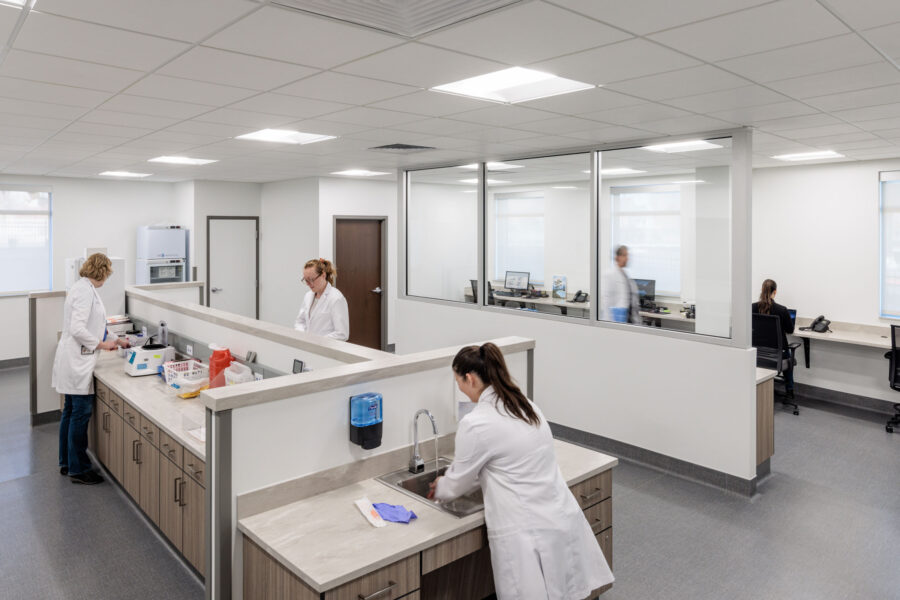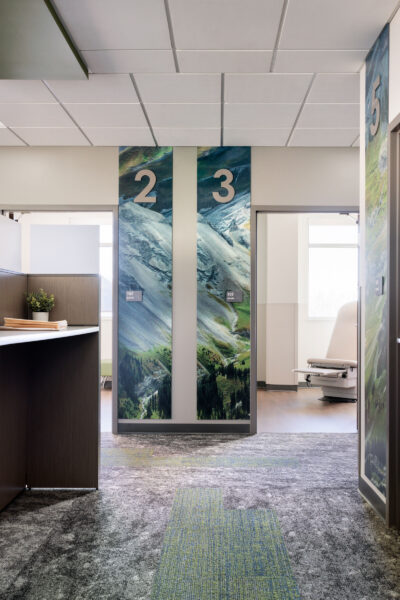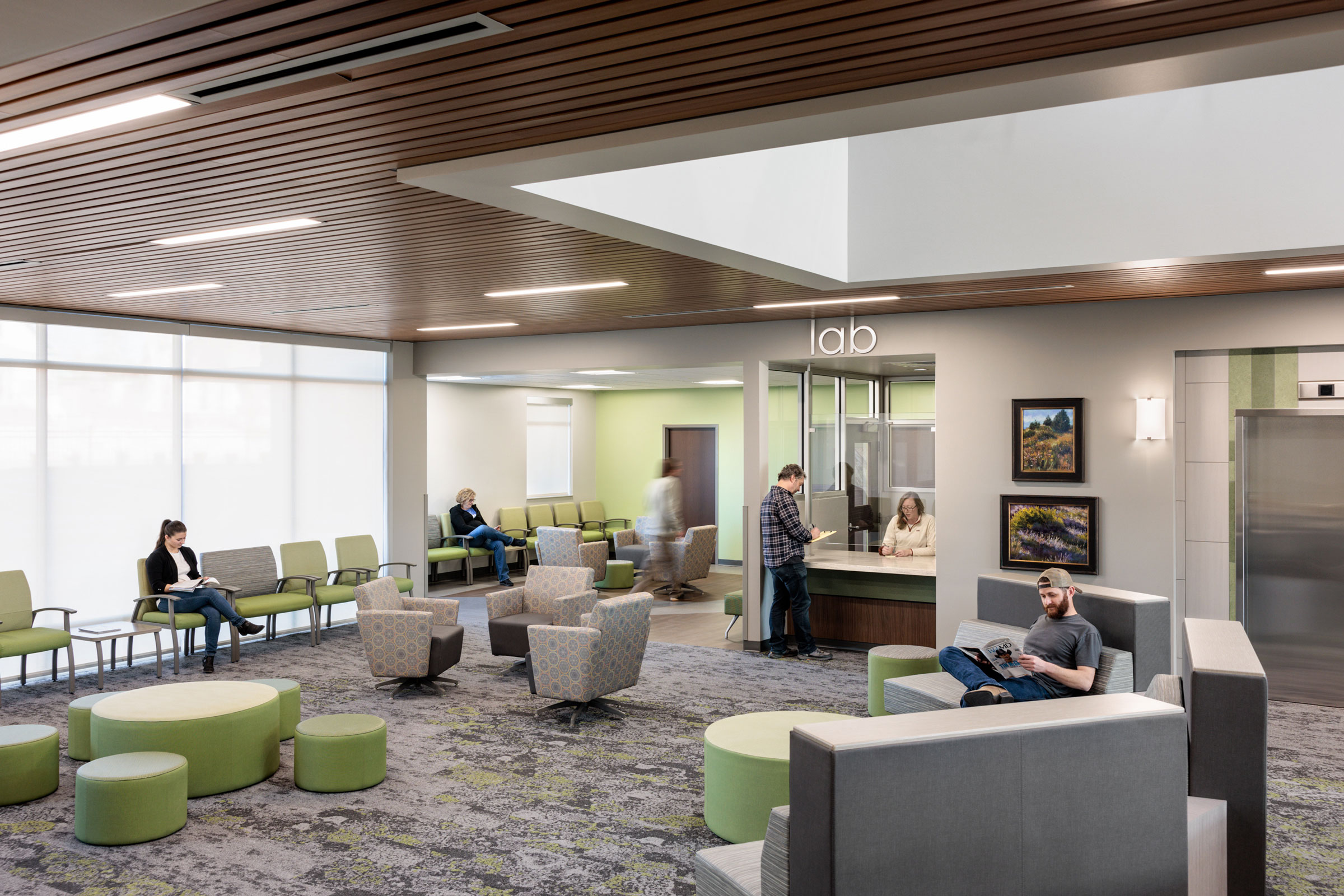Story at a glance
- Mohawk Group provides comforting flooring options for modern health care settings.
- Calming spaces can lead to better outcomes, according to experts at Perkins&Will.
If you close your eyes and picture a stereotypical health care setting, you probably don’t envision a beautiful space. Instead, it might look functional with machines and specialized equipment but dressed in a drab palette of gray and beige and awash with fluorescent light. Perhaps a beach scene adorns a wall, or a plastic plant sits on a counter.
Thankfully there’s a much warmer, vibrant approach taking hold. Today’s designers of health care spaces are embracing biophilia by incorporating natural light, calming color palettes, and natural textures to bring the aesthetics up to the standard of their caregiving.
These changes are evident from the wall coverings all the way down to the floor—where Mohawk Group leads the industry in developing flooring solutions that are beautiful, durable, and sustainable, among other benefits. Here we explore the importance of modern health care flooring.
Form and Function

Resilient sheet by Mohawk Group. Photo by David Lauer Photography
Infusions of color can create a warmer, more welcoming space compared to the chilly, sterile impression that dominated the industry for decades. This is especially true in clinical settings, says Elizabeth Bonner, director design segment at Mohawk Group, who specializes in health care and hard surface flooring.
The weight of medical equipment demands a durable product that can stand up to pressure, necessitating a focus on function over form. “Compression becomes an issue. We want to make soft, cushy floors for health care that feel great underfoot, but that does not work with the equipment that’s there,” Bonner says.
We’re considering visuals for the floor that might look more like natural wood. It’s going to increase your comfort level.
Color is key in creating a product that performs at a high level while still aligning with biophilic principles. “Where we may have offered products that really suited a technical need in white, off-white, black, and a really narrow range of grays, now we’re seeing those products expand to include colors that are a little more comforting—some blues, greens, warmer tones,” Bonner says.
Mohawk Group’s catalog of durable hard flooring products also includes visuals that mimic wood, bamboo, and other natural materials. “Now we’re considering visuals for the floor that might look more like natural wood, even in a hospital room where you typically wouldn’t see that kind of thing,” Bonner says. “It’s going to increase your comfort level in a space like that versus feeling like you’re lying in a lab.”

Mohawk Group’s Serenity combines the look of warm wood with the performance of specialized hard surface flooring inside the Pueblo Community Health Center East Side Clinic. Photo by David Lauer Photography
The Pueblo Community Health Center East Side Clinic, designed by RTA Architects, is a great example of what’s possible. There, washes of green and natural textures give the space warmth. In the waiting rooms and corridors Mohawk Group’s Lichen collection of carpet tiles is used; the design was inspired by the hues and textures of lichens and their regenerative role in the ecosystem. In clinical spaces where heavy equipment is located and easy maintenance is needed, Mohawk Group’s Healthy Environments Collection—featuring the Serenity style resilient sheet—combines the look of warm wood with the performance of specialized hard surface flooring.
Studies have proven that connecting health care environments to natural healing motifs can aid in better outcomes, as the biophilic design is linked to health gains. A beautiful space can also provide a more comfortable backdrop for the circumstances we all face in health care settings. Hospital rooms are where we first meet our children, fight life-threatening diseases and illnesses and say goodbye to loved ones. “A lot of times you’re interacting with these spaces on what could possibly be some of the worst days of your life. If you can provide a touch of comfort on those days, it makes a big difference,” Bonner says.
Patients aren’t the only ones who benefit from these changes, though. The pandemic peeled back the curtain on unhealthy patterns affecting health care workers, and the design of health care spaces is increasingly informed by strategies and techniques to improve the staff experience. For example, lavender rooms are being incorporated to allow for moments of respite during stressful situations for health care workers.
Creating these spaces can help staff meet demands and ultimately produce a better experience for patients, says Jolene Mudri, senior interior design project manager with Perkins&Will. “Providing those healing amenities for health care providers will help mitigate staff burnout, which is extremely critical right now,” she says.
The Sustainability Story

Mohawk Group’s Lichen flooring is seen here in a health care space designed by RTA Architects. Photo by David Lauer Photography
Sustainability is top of mind for both health care clients and Mohawk. Following a decade-long commitment, all of Mohawk’s products are carbon neutral. Soft surface options that are manufactured in Living Product Challenge–compliant facilities are also water-positive.
Focusing on manufacturing is how the company fulfills its pledge to provide sustainable options at all price points, ensuring clients with fewer resources can still make responsible choices that look good. “We’re giving you solutions that are both. We’re building sustainability into everything,” Bonner says. “We talk a lot about design equity and inclusion, that a space with a low budget should be able to make the same informed decisions as a space with a higher budget.”
Mohawk Group is committed to transparency so clients can make informed decisions with Declare Red List Free labels. Knowing a product’s contents is especially important in health care spaces. “When you’re in a hospital and you don’t have operable windows, having good indoor air quality is extremely important.
Being able to specify products that are in alignment with indoor air quality to create holistic healing environments is extremely important,” Mudri says. Mohawk Group makes these decisions easier with clear labeling. “If you’re looking for their metrics and whether or not they comply with Red Label listings, they have all that readily available on the website. It’s very user-friendly,” Mudri says.
Mohawk Group also leads in providing hard surface options that don’t off-gas, like the newly launched Medella Well line of resilient sheet. This resilient sheet is the preferred choice in clinical areas with the most complex performance demands—think surgery suites with heavy equipment and intense pressure for the cleanest possible environment—and polyvinyl chloride, or PVC, is the chemical compound that most often keeps this flooring product stable. Earlier this year Mohawk Group answered the call for PVC-free resilient sheet flooring with Medella Well—an unparalleled resilient sheet product that is free of plasticizers, ortho-phthalates, halogens, isocyanates, and Red List chemicals of concern. “That’s at the forefront of our sustainability conversation for those spaces,” Bonner says.
Medella Well was stringently designed and tested to ensure it performs. “It does all of the right things for those types of spaces, just without one component,” Bonner says. And just like other products in Mohawk’s Healthy Environments line, Medella Well is coated with Mohawk Group’s M-Force™ Ultra protective layer. “It’s your last coat between the product and the world,” Bonner says. “Ours is set up to be super easy maintenance. It’s not something that has to be polished and waxed. It’s just regular mopping.”
A high-performance product that meets the demands of the clinical setting without plasticizers is a breakthrough, Mudri says, with the potential to improve patient outcomes. “Getting rid of all those resins is an amazing step forward,” she says.

